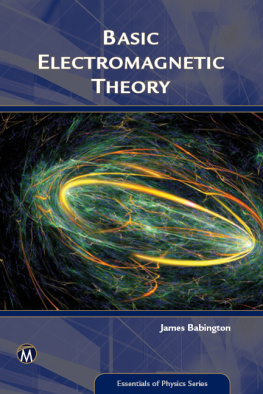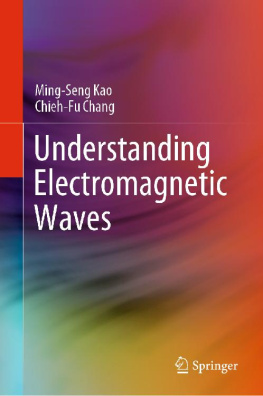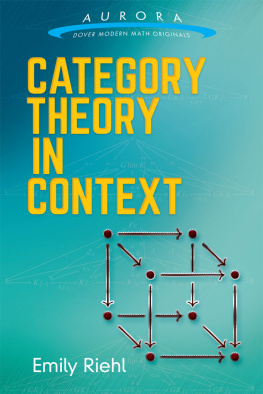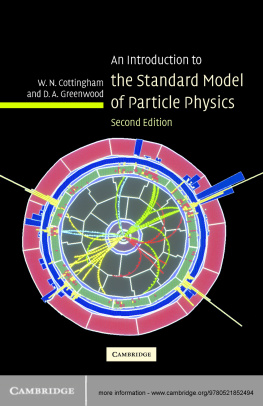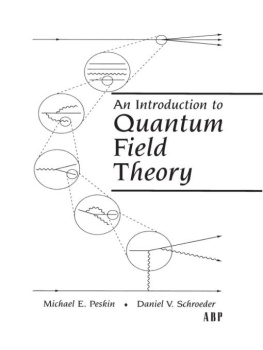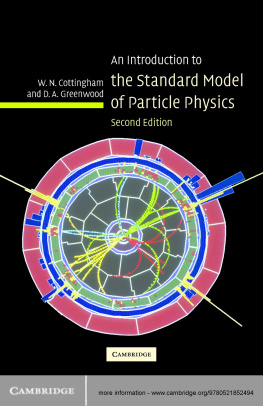
B ASIC E LECTROMAGNETIC T HEORY
LICENSE, DISCLAIMER OF LIABILITY, AND LIMITED WARRANTY
By purchasing or using this book (the Work), you agree that this license grants permission to use the contents contained herein, but does not give you the right of ownership to any of the textual content in the book or ownership to any of the information or products contained in it. This license does not permit uploading of the Work onto the Internet or on a network (of any kind) without the written consent of the Publisher. Duplication or dissemination of any text, code, simulations, images, etc. contained herein is limited to and subject to licensing terms for the respective products, and permission must be obtained from the Publisher or the owner of the content, etc., in order to reproduce or network any portion of the textual material (in any media) that is contained in the Work.
MERCURY LEARNING AND INFORMATION (MLI or the Publisher) and anyone involved in the creation, writing, or production of the companion disc, accompanying algorithms, code, or computer programs (the software), and any accompanying Web site or software of the Work, cannot and do not warrant the performance or results that might be obtained by using the contents of the Work. The author, developers, and the Publisher have used their best efforts to insure the accuracy and functionality of the textual material and/or programs contained in this package; we, however, make no warranty of any kind, express or implied, regarding the performance of these contents or programs. The Work is sold as is without warranty (except for defective materials used in manufacturing the book or due to faulty workmanship).
The author, developers, and the publisher of any accompanying content, and anyone involved in the composition, production, and manufacturing of this work will not be liable for damages of any kind arising out of the use of (or the inability to use) the algorithms, source code, computer programs, or textual material contained in this publication. This includes, but is not limited to, loss of revenue or profit, or other incidental, physical, or consequential damages arising out of the use of this Work.
The sole remedy in the event of a claim of any kind is expressly limited to replacement of the book, and only at the discretion of the Publisher. The use of implied warranty and certain exclusions vary from state to state, and might not apply to the purchaser of this product.
B ASIC E LECTROMAGNETIC T HEORY
Field Theory Foundations and Structure
JAMES BABINGTON

MERCURY LEARNING AND INFORMATION
Dulles, Virginia
Boston, Massachusetts
New Delhi
Reprint and Revision Copyright 2017 by MERCURY LEARNING AND INFORMATION LLC. All rights reserved.
Original title and copyright: Basic Electromagnetic Theory: Field Theory Foundations and Structure. Copyright 2013 by James Babington. All rights reserved. Published by The Pantaneto Press.
This publication, portions of it, or any accompanying software may not be reproduced in any way, stored in a retrieval system of any type, or transmitted by any means, media, electronic display or mechanical display, including, but not limited to, photocopy, recording, Internet postings, or scanning, without prior permission in writing from the publisher.
Publisher: David Pallai
MERCURY LEARNING AND INFORMATION
22841 Quicksilver Drive
Dulles, VA 20166
www.merclearning.com
800-232-0223
This book is printed on acid-free paper.
James Babington. Basic Electromagnetic Theory.
ISBN: 978-1-942270-74-4
The publisher recognizes and respects all marks used by companies, manufacturers, and developers as a means to distinguish their products. All brand names and product names mentioned in this book are trademarks or service marks of their respective companies. Any omission or misuse (of any kind) of service marks or trademarks, etc. is not an attempt to infringe on the property of others.
Library of Congress Control Number: 2016935946
161718321 Printed in the United States of America
Our titles are available for adoption, license, or bulk purchase by institutions, corporations, etc. For additional information, please contact the Customer Service Dept. at 800-232-0223(toll free).
All of our titles are available in digital format at authorcloudware.com and other digital vendors. The sole obligation of MERCURY LEARNING AND INFORMATION to the purchaser is to replace the book, based on defective materials or faulty workmanship, but not based on the operation or functionality of the product.
This book is intended as a short introduction to the foundations of electromagnetic field theory. It has been based on my experience both as a former field theorist (working on quantum field theories, quantum electrodynamics and Casimir physics) and currently as an applied optical physicist. Indeed, my thoughts were in the last couple of years to simply write down what I thought I knew and try to critically examine this. What has been very interesting to see is that, in my opinion, an appreciation of its history together with the characters involved is a necessity to get to grips with the foundations of the subject, and therefore understanding at a deeper level.
I was fortunate enough as an undergraduate to be exposed to some quite advanced electromagnetic field theory early on. My then tutor, Robin Devenish, at Hertford College, Oxford, set me some very interesting problems on electromagnetic fields written in the four-vector notation of special relativity at the end of my first year. This was real classical field theory that one would typically study before moving on to quantum fields. It came about because I actually wanted to study the general theory of relativity, and I had asked him how to get into it. In hindsight, these were exactly the right problems to work on over a summer vacation, and I thank him greatly for his direction here.
My prejudice is clearly going to be skewed towards the field theory aspects. However, and importantly, I have not shied away from experimental and measurement issues that ultimately are the reason for introducing a field theory in the first place. In particular, the historical demonstration of a principle, or the quantification of a law takes first place. The mathematics should be there to capture the essence of any experimental studies and provide a language with which to ask further questions. With this in mind, I am assuming on the part of the reader a genuine interest in the subject and present the material from this standpoint.
I have included some problems at the end with solutions; these are meant to illuminate parts of the text with either a definite calculation method, or to just see some numbers. In addition to these, exercises are scattered throughout the text to give a little poke to the reader to interact.
Finally, I would like to dedicate this book to my wife Serena and my son Albert with the very greatest affection.
James Babington
June 2016
Electromagnetism is perhaps the most basic theory we see around us in the natural world. It is responsible for the color we see, the forces that bind us together and for any technology beyond the steam engine. It is the theory par excellence in that it is responsible for the macroscopic world around us that we are part of and interact with. But it goes far beyond this as it is also the gateway to the sub-atomic world that tries to ultimately explain the existence of matter and forces. From these concepts must emerge the structures such as the atomic nuclei that are necessary to get any form of life going. Modern particle physics theories that try to explain the nature of quarks and the very small, and the evolution and dynamics of the universe on the other, take as their starting point something that looks quite similar to electromagnetism (that is the central role of gauge theories and symmetry as a governing principle).
Next page
